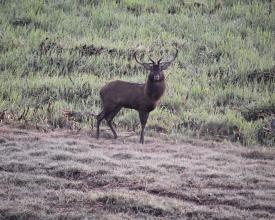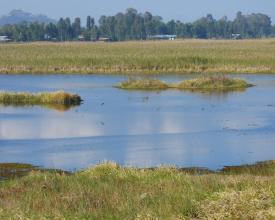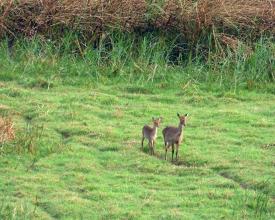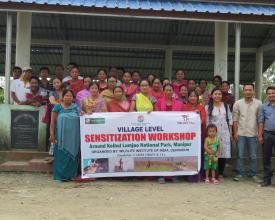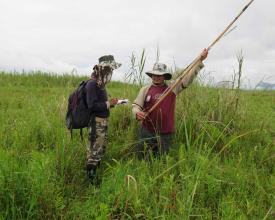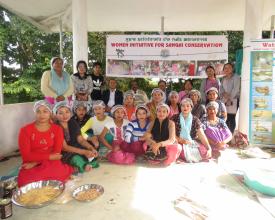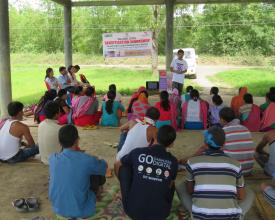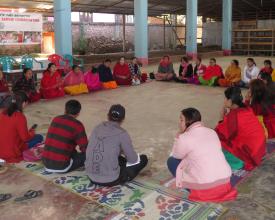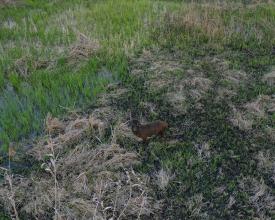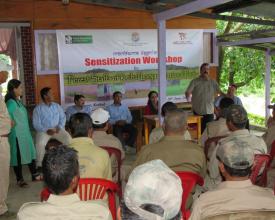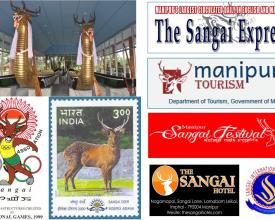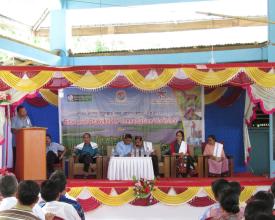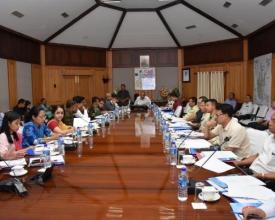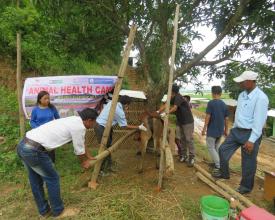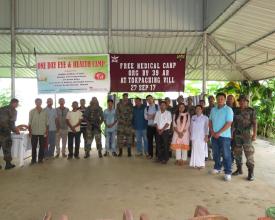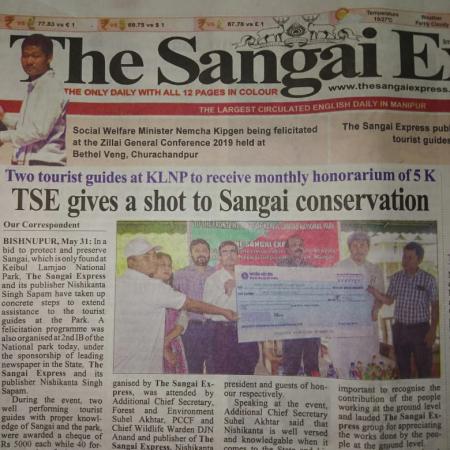
Conservación a la puerta de casa: Asegurar la población de una especie de ciervo en peligro crítico
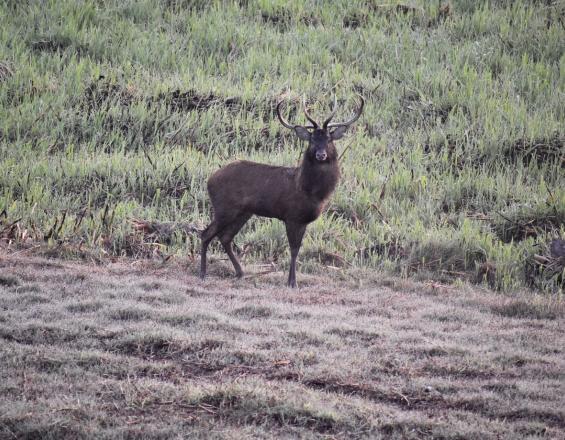
El ciervo de Eld o ciervo de anteojos Rucervus eldii eldii es una de las especies de cérvidos más amenazadas del mundo. El ciervo de Eld, también conocido como Sangai, existe como población única, aislada y pequeña en las praderas flotantes del Parque Nacional de Keibul Lamjao, en Manipur (India). La población y el hábitat del Sangai se están protegiendo mediante un planteamiento múltiple que utiliza la interfaz científica, social y política.
Contexto
Défis à relever
El Parque Nacional de Keibul Lamjao (KLNP) es el último hábitat natural de Sangai. El Parque ocupa una superficie de 40 km2, de los cuales sólo 23 km2 son praderas flotantes y el resto son aguas abiertas y lomas. Estas praderas flotantes forman el hábitat principal, que proporciona alimento, refugio y lugares de cría. El sangai se consideraba extinto hasta que se redescubrió una pequeña población de unos 14 individuos a principios de la década de 1950.
El hábitat del Sangai, las praderas flotantes, es el más singular del mundo. Aunque Sangai está considerado el orgullo de Manipur, la población local desconocía la singularidad de su hábitat y extraía recursos del Parque. La extracción desenfrenada de recursos causaba perturbaciones en el hábitat, especialmente durante la época de celo. La falta de concienciación también había dado lugar a un pastoreo de ganado no regulado y sin restricciones.
Ubicación
Procesar
Resumen del proceso
En el Parque Nacional de KLN y el paisaje adyacente se está aplicando un planteamiento en cuatro fases, que incluye una combinación de estudios científicos, concienciación, defensa e intervenciones políticas, y apoyo a los medios de subsistencia. Se han realizado estudios científicos para generar información sobre la dependencia de los recursos de las comunidades locales, así como sobre el impacto de dicha dependencia en Sangai y su hábitat. Se están llevando a cabo programas de concienciación en todo el estado diseñados para grupos específicos. Periódicamente se celebran consultas con las comunidades locales y otras partes interesadas a distintos niveles de gobierno. Estos talleres han ayudado a crear una mayor base de apoyo para la conservación del Sangai, tanto a nivel de gestión como político y de base. Se está garantizando la participación activa de las comunidades locales y de las diferentes partes interesadas en la gestión del Parque para una conservación satisfactoria de Sangai mediante diversos programas de desarrollo de capacidades, con el objetivo de proporcionar medios de vida alternativos. Además de los talleres para las partes interesadas y los programas de capacitación, también se están llevando a cabo programas de fomento de la confianza, como campamentos sanitarios para personas y ganado, y suministro de agua potable durante las inundaciones.
Bloques de construcción
Protección de la población existente en el Parque Nacional de Keibul Lamjao
La población existente de Sangai se está asegurando mediante un plan de gestión integrada, aplicado por el Departamento Forestal de Manipur. El plan de gestión integrada implica estrategias continuas de gestión del hábitat, seguimiento del hábitat y de la población, mejora de las estrategias de patrulla, estudios genéticos y participación de las comunidades locales y las distintas partes interesadas en el KLNP.
Factores facilitadores
1. 1. Interés del departamento forestal estatal.
2. Sangai es un símbolo cultural importante en Manipur, y por lo tanto es considerado como orgullo de Manipur, por la población local y el Gobierno de Manipur.
3. 3. El apoyo del Gobierno de la India, que proporciona financiación y otras ayudas.
Lección aprendida
1. Un trabajo de campo riguroso es fundamental para identificar las necesidades de hábitat del Sangai y otros aspectos relacionados con la gestión de la población.
2. El seguimiento continuo garantiza el éxito a largo plazo.
Participación de las comunidades locales en el proceso de conservación
Para recabar apoyo político y local a la conservación de Sangai en el Parque Nacional de KLN, se han llevado a cabo actividades de promoción entre todas las partes interesadas. Además, se están tomando medidas adecuadas para sensibilizar a la población local sobre la conservación de la especie y promover el sangai como mascota del desarrollo sostenible mediante diversos programas de capacitación.
Factores facilitadores
1. Interés del departamento forestal estatal.
2. Sangai es un símbolo cultural importante en Manipur, y por lo tanto es considerado como orgullo de Manipur, por la población local y el Gobierno de Manipur.
3. 3. El apoyo del Gobierno de la India, que proporciona financiación y otras ayudas.
Lección aprendida
1. El diálogo entre múltiples partes interesadas genera transparencia y confianza.
2. Es indispensable abordar los medios de subsistencia de las comunidades locales que dependen de los recursos .
Impactos
Como resultado del enfoque de cuatro pasos adoptado para la conservación del Sangai, se ha puesto en marcha un régimen de gestión científica para la conservación del Sangai en el PNKL a través de la investigación y la consulta con las comunidades locales dependientes y otras partes interesadas. Estas intervenciones están creando un entorno positivo para el desarrollo de un grupo social más amplio para la conservación del Sangai, así como para el desarrollo sostenible de las comunidades locales.
Beneficiarios
Gestores de áreas protegidas (a nivel de sitio, autoridad de gestión o gobierno local), comunidad local y comunidad científica.
Objetivos de Desarrollo Sostenible
Historia

Para hacer frente a estos retos, el Wildlife Institute de la India llevó a cabo investigaciones sobre la ecología del hábitat y la alimentación, la demografía y el estado genético del Sangai. También se evaluó la situación socioeconómica de los habitantes de los alrededores del PNKL y su dependencia de los recursos del parque. La investigación, que duró más de una década, dio como resultado información que se comunicó a una amplia gama de interesados. Se emprendieron una serie de debates y reuniones con las comunidades que residen en la periferia del parque. Durante estas reuniones, se informó a los miembros de la comunidad sobre los problemas de conservación de Sangai y los miembros de la comunidad discutieron los problemas a los que se enfrentaban. Estos diálogos y reuniones pusieron de relieve la necesidad de mejorar la situación socioeconómica de la población local mediante opciones de subsistencia sostenibles alternativas, que a su vez reducirían la dependencia de los recursos del parque. Así pues, también se exploraron opciones alternativas de subsistencia mediante consultas y diálogos con los miembros de la comunidad. Durante estas reuniones, se acordó capacitar a las comunidades locales mediante la promoción de medios de vida alternativos respetuosos con la conservación, en el marco de iniciativas de ecodesarrollo en los pueblos de los alrededores. Por ello, se impartió a las mujeres una serie de cursos de formación sobre el valor añadido de los recursos locales y a los jóvenes sobre ecoturismo.
Dado que el de guía turístico es un concepto relativamente extraño en Manipur, los turistas no estaban dispuestos a pagar honorarios a los guías ecoturísticos, por lo que la mayoría de los guías ecoturísticos formados se marcharon en busca de mejores oportunidades de ingresos. Sin embargo, dos de los jóvenes formados siguieron trabajando como guías ecoturísticos. Apreciando la perseverancia y dedicación de estos dos guías, un importante periódico de Manipur "The Sangai Express", en virtud de su responsabilidad social corporativa, les dio puestos honoríficos de por vida, con un salario mensual regular y un incremento anual. Esto motivó a estos dos jóvenes locales a seguir trabajando como guías ecoturísticos.

